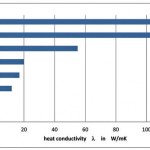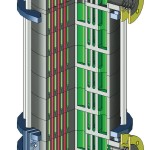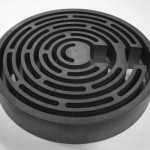Silicon carbide is a very solid, hard and temperature resistant material. Thanks to its excellent chemical resistance and thermal conductivity, it is ideal for the construction of heat exchangers. Alongside the classic shell & tube heat exchangers, other exchanger types can also be implemented.
The authors: Tobias Schnurpfeil CEO, GAB Neumann Matthias Reitz Product Manager SiC Products, GAB Neumann
The material SiC (silicon carbide) has a complete lack of ductility towards metals and other properties, so that innovative solutions are called for from engineers and technology experts when it comes to larger component volumes and dimensions. In particular, the hardness and brittleness of the ceramic impose restrictions on the processing of the sintered product. Generally speaking, the form of the ceramic component is created in the so-called green state. The ability to master the processing methods has a significant influence on cost structures. This difficulty may be one reason for the long-term insistence of many manufacturers on the SiC shell & tube type.
One outstanding advantage of silicon carbide is its almost universal chemical resistance. At this point, it should be emphasised that there is a difference between directly sintered SiC, or SSiC, and silicon infiltrated SiC, also referred to as SiSiC. The proportion of free silicon in silicon infiltrated SiC can be up to 16 %, depending on the method used. This component may be subject to chemical attack and washed out. In addition to product contamination, this results in considerable material damage. SSiC types are almost always used in SiC heat exchangers for corrosion resistant applications for this reason. However, the literature only includes very few resistance studies and these are not very comprehensive. According to their findings, only SSiC is suitable for long-term use. This conclusion is supported more by the many years of experience in a wide range of applications than by the scant published statistics.
Another essential criterion for application recommendations is the purity of the material and the lack of any tendency to contaminate the product. The manufacturing technology and sintering process can cause dusts to build up on the SiC surface, leading to errors of interpretation. For use in the highly pure area of electronic chemicals, SiC is washed in a defined chemical mixture and the particle removal efficiency measured. The results show that the material is suitable for use at ppt purity levels.
Silicon carbide also performs excellently when the thermal conductivity of corrosion resistant materials is compared. Its very good conductivity is, however, often overvalued by technical journals when assessing its effect on the thermal transfer coefficient and hence on the size and efficiency of a heat exchanger, since this is only one of several summands in the calculation formula. In addition, thermal conductivity is linked to the thermal shock resistance via the Biot number. The thermal shock stability R1, which can also be seen as the short-time temperature difference, is approximately 200 K for SSiC, depending on the type. This is an important parameter for the start-up processes of heat exchangers that covers almost the entire range of permitted operating temperatures for the apparatus.
Various types of apparatus
Owing to its comparatively simple design, the shell & tube type is traditionally the dominant SiC heat exchanger. For want of suitable alternatives, SiC shell & tube heat apparatus has often been used in the past in processes for which it is not ideally suited.
GAB Neumann’s Corresic heat exchangers are made using monolithic silicon carbide (SSiC). The range includes shell & tube, block and annular groove exchanger types. SiC heat exchangers can thus be offered for specific processes. The technological innovations generated by green processing, the increase to 100 % process reliability and the development of suitable joining processes such as the Tasic method were driving forces behind this great diversity.
The Corresic series opens the door for more widespread use of SiC in process industry heat exchangers. A high chemical resistance combined with minimal wear, very good thermal properties and the optimal hydrodynamic conditions facilitated by the design and material all contribute to improving process efficiency.
Hall 4.0, Booth F65
cpp-net.com/0212437
Share:











